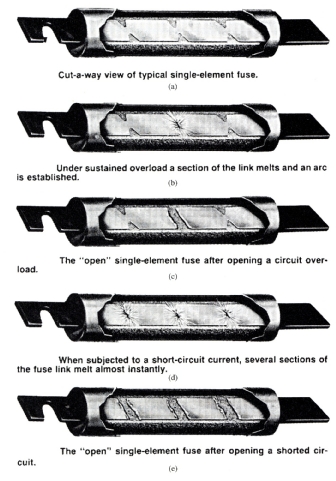 Right: Fig. 1 (a) Cut away picture of
single-element fuse before it has developed an open. (b) Cut away picture
of a sing le-element fuse that shows an arc established at the middle
neck-down section when the current is too large. (c) The middle neck-down
section has completely opened after the current exceeded the maximum
level. (d) Arcs are established at each neck- down section of the fuse
when severe overcurrent is experienced. (e) All of the neck-down sections
develop opens when the severe over- current continues. Under sustained
overload a section of the link melts and an arc is established. When
subjected to a short-circuit current several sections of the fuse link
melt almost instantly. (d) Cut-a-way view of typical single-element fuse.(a)
(b) The “open” single-element fuse after opening a circuit over load.
(c) The “open” single-element fuse after opening a shorted circuit.
Right: Fig. 1 (a) Cut away picture of
single-element fuse before it has developed an open. (b) Cut away picture
of a sing le-element fuse that shows an arc established at the middle
neck-down section when the current is too large. (c) The middle neck-down
section has completely opened after the current exceeded the maximum
level. (d) Arcs are established at each neck- down section of the fuse
when severe overcurrent is experienced. (e) All of the neck-down sections
develop opens when the severe over- current continues. Under sustained
overload a section of the link melts and an arc is established. When
subjected to a short-circuit current several sections of the fuse link
melt almost instantly. (d) Cut-a-way view of typical single-element fuse.(a)
(b) The “open” single-element fuse after opening a circuit over load.
(c) The “open” single-element fuse after opening a shorted circuit.
Single-element fuses basically provide overcurrent protection at one level. Figure 1 shows several cut-away pictures of single-element fuses. From Figure 1a notice that the single-element fuse is made of a single conducting element with several neck-down sections. The neck-down sections provide a point where the short-circuit current will be concentrated and cause the metal to melt. Since the element is made of thin metal, the larger the short-circuit current becomes, the more quickly the element will melt.
Figure 1b shows an arc that is established at the center neck-down section when the fuse experiences a current that exceeds the current rating for the fuse. Figure 1c shows how the arc continues to grow until the neck-down section is melted to cause an open.
Figure 1d shows an arc established at each of the neck-down sections when the current is exceedingly large. When the large current is experienced, it may be large enough to cause the fuse to melt several or all of its neck-down sections at the same time. Figure 1e shows a fuse with all of its neck-down sections open.

